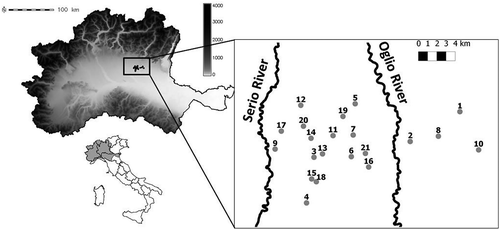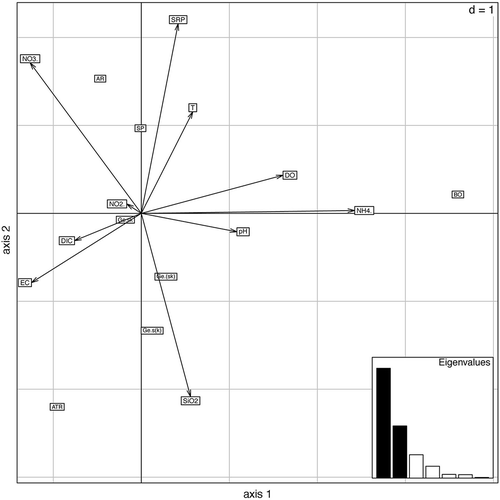Figures & data
Fig. 1. Study area with the location of the lowland springs (fontanili) sampled (1: Averolda, 2: Becchilsù, 3: Belprato, 4: Boscovito, 5: Ca Nova, 6: Calcio, 7: Cavetti, 8: Chigaluzza, 9: Cna Volpe, 10: Crocetta, 11: Est Pompiano, 12: Fascina, 13: Isso Grande, 14: Isso Piccolo, 15: Lametta, 16: Mirandola, 17: Negroni, 18: Palazzina, 19: Pellegrina, 20: Pratizagni, 21: Saragozza, 22: Serafina, 23: Zemia). For more detailed location data see Supplementary . All fontanili were between 40° 23′−40° 30′ longitude and 9° 43′−10° 0′ latitude.

Figs 2–14. Batrachospermum gelatinosum. Fig. 2. Whorls with carposporophytes. –. Lanceolate, sessile trichogynes with more or less elongated end and more or less swollen central part (marked Ge.(sk) in the text) from specimens collected at springs Pellegrina (), Isso Piccolo (), and Crocetta (sequenced specimen, ). , . Deformed trichogynes with long basal stalk or just a hinted knob (marked Ges(k) in the text) from a specimen collected at Cna Volpe, the spring with the best environmental conditions among the 23 investigated. –. Deformed trichogynes with more or less long stalk and knobs (marked Ge.sk in the text) from specimens collected in three springs with the poorest environmental conditions [Pratizagni (), Saragozza (), Fascina ()]. . Three carpogonia on the same fascicle branch from the sequenced specimen collected at the spring Averolda. Note the basal knob (arrow) on trichogyne of the central carpogonium (arrow). . Two carpogonia on the same fascicle branch from the sequenced specimen collected at the spring Est Pompiano, the one on the left with stalk and knob (arrow). , . B. gelatinosum f. spermatoinvolucrum. Specimen sequenced with spermatangia on the top of involucral filaments (arrowheads). , scale bar = 50 µm; –, scale bar = 20 µm.
![Figs 2–14. Batrachospermum gelatinosum. Fig. 2. Whorls with carposporophytes. Figs 3–5. Lanceolate, sessile trichogynes with more or less elongated end and more or less swollen central part (marked Ge.(sk) in the text) from specimens collected at springs Pellegrina (Fig. 3), Isso Piccolo (Fig. 4), and Crocetta (sequenced specimen, Fig. 5). Figs 6, 7. Deformed trichogynes with long basal stalk or just a hinted knob (marked Ges(k) in the text) from a specimen collected at Cna Volpe, the spring with the best environmental conditions among the 23 investigated. Figs 8–10. Deformed trichogynes with more or less long stalk and knobs (marked Ge.sk in the text) from specimens collected in three springs with the poorest environmental conditions [Pratizagni (Fig. 8), Saragozza (Fig. 9), Fascina (Fig. 10)]. Fig. 11. Three carpogonia on the same fascicle branch from the sequenced specimen collected at the spring Averolda. Note the basal knob (arrow) on trichogyne of the central carpogonium (arrow). Fig. 12. Two carpogonia on the same fascicle branch from the sequenced specimen collected at the spring Est Pompiano, the one on the left with stalk and knob (arrow). Figs 13, 14. B. gelatinosum f. spermatoinvolucrum. Specimen sequenced with spermatangia on the top of involucral filaments (arrowheads). Fig. 2, scale bar = 50 µm; Figs 3–14, scale bar = 20 µm.](/cms/asset/ad6ce946-5726-40c1-af41-44d172198979/tejp_a_1055592_f0002_b.gif)
Table 1. Physical-chemical parameters for fontanili in which species of Batrachospermum and Sheathia occurred.
Fig. 15. Biplot of the first two axes from the niche analysis. AR = Sheathia arcuata; BO = S. boryana; ATR = Batrachospermum atrum; SP = B. gelatinosum f. spermatoinvolucrum; Ge.sk = specimens of B. gelatinosum with more than 30% trichogynes deformed by knobs and stalks Ge.(sk) = specimens of B. gelatinosum with fewer than 30% trichogynes deformed by knobs and stalks; Ge.s(k) = specimens of B. gelatinosum with more than 30% trichogynes deformed almost exclusively by long stalks.

Fig. 16. Scatter plot on the first factorial plan from the niche analysis of species and springs. AR = Sheathia arcuata; BO = S. boryana; ATR = Batrachospermum atrum; SP = B. gelatinosum f. spermatoinvolucrum; Ge.sk = specimens of B. gelatinosum with more than 30% trichogynes deformed by knobs and stalks; Ge.(sk) = specimens of B. gelatinosum with fewer than 30% trichogynes deformed by knobs and stalks; Ge.s(k) = specimens of B. gelatinosum with more than 30% trichogynes deformed almost exclusively by long stalks.

Table 2. Results of the Poisson regression for Batrachospermum gelatinosum groups and fontanili environmental variables.
